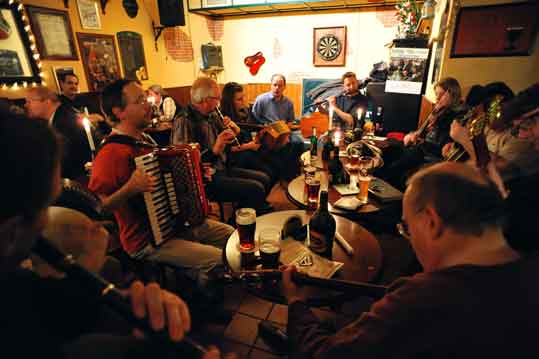KINDRED LINES: IRISH TRADITIONAL MUSIC ARCHIVE
Published in Features, Issue 2 (March/April 2023), Volume 31By Fiona Fitzsimons
Irish traditional music is both an oral tradition and an art form. It often, though not always, has no set composer and is rooted in a community of practice. It is dynamic and subject to change as artists interpret it, but also as the knowledge and skills are passed between generations of musicians.
Although music is probably the most accessible part of traditional Irish culture, can it ever retain the kind of evidence we look for in family history? I believe that it can and does, and that we should give some thought as to how we use it in research.
We cannot separate Irish traditional music from the families and communities from which it springs. The music they make is a response to the inherited tradition, to the local environment and to history. We find evidence of personal names, place-names, great events and local rows documented in the music. Musical families are common in Irish traditional music. We often hear musicians described as having a ‘musical inheritance’ of generations. This phrase means much more than an innate ability. It includes the early exposure to music: the absorption that brings someone at a young age to practise consistently and deliberately, developing a musical memory, learning the canon and a wider range of influences and how to communicate feeling in the performance.
Dolores Keane ‘learned what singing was’ from her aunts Rita and Sarah Keane, both well-known sean-nós singers, themselves members of the Keane Family Ceilidh Band. Martin Hayes’s father, P.J. Hayes, and his uncle, Paddy Canny, were influential fiddle-players. We find dynasties of uilleann pipers—the Rowsomes, the Dorans and Cashes, Irish Traveller families with a distinguished musical heritage.
The relationship between Traveller culture and Irish traditional music is a given. It may provide a ‘way in’ to explore Traveller family history. Travellers were migratory for part of the year. What records they left are dispersed. If they had common names (Connors, Doherty, MacDonagh etc.), it is difficult to separate them out from their doppelgangers, without more corroborative evidence such as a permanent address. Many of the renowned Traveller musicians are documented, however, in the Irish Traditional Music Archive (ITMA) and the National Folklore Collection. By tracing the footsteps of Traveller musicians, we can often follow the families and find them in the records.
The ITMA has a comprehensive library of the commercial output of traditional music (documentaries, recordings, publications, books, sheet-music). Its archival holdings include the papers, music manuscripts and correspondence of some of the greats, including Liam O’Flynn, Grainne Yeats, Tomás Ó Canainn, Derek Bell and other prominent musicians. It also has audio collections of non-commercial recordings (reel-to-reel tapes, cassettes, acetate discs). The ITMA has created a comprehensive catalogue of names, an authority collection, so that people can navigate the archival holdings to find musician ancestors. It aims to provide the English and Irish versions of names, so that no one slips under the radar.
One of the most intriguing collections, from a family history perspective, are the programmes of the Feis Ceoil (from the 1890s) and the Fleadh Cheoil (after 1951). These have a wealth of names of performers and competitors, placing them in a location on a given date. This collection is as yet uncatalogued and you have to do a ‘fingertip search’ to mine it for information.
Irish Traditional Music Archive, 73 Merrion Square South, D02 WK75, 10am–1pm, 2–5pm (https://www.itma.ie/).
Fiona Fitzsimons is a director of Eneclann, a Trinity campus company, and of findmypast Ireland.

















